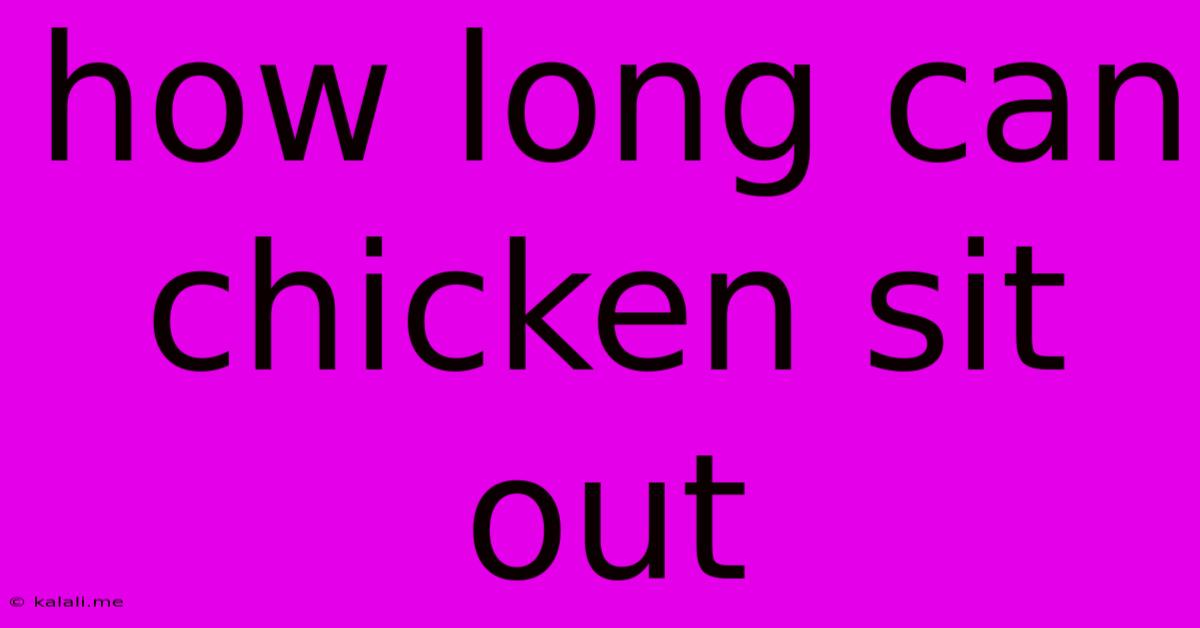How Long Can Chicken Sit Out
Kalali
May 21, 2025 · 3 min read

Table of Contents
How Long Can Chicken Sit Out? A Guide to Food Safety
Leaving cooked chicken out at room temperature can be a risky business. Understanding how long chicken can safely sit out is crucial to prevent foodborne illnesses like Salmonella and Campylobacter. This guide will delve into the specifics, helping you avoid potential health hazards. Knowing the safe time limits for leaving chicken out is essential for food safety and preventing illness.
The Danger Zone: Temperature and Bacteria
The "danger zone" for food safety is generally considered to be between 40°F (4°C) and 140°F (60°C). Within this temperature range, bacteria multiply rapidly. Cooked chicken, once removed from refrigeration, quickly enters this danger zone. The longer it sits, the higher the risk of bacterial growth, leading to food poisoning.
How Long is Too Long?
The general rule is that cooked chicken should not sit out at room temperature for more than two hours. This applies to both whole cooked chickens and chicken leftovers. After two hours, the risk of bacterial contamination becomes significantly higher.
In hotter environments (above 90°F or 32°C), the limit is even stricter: one hour is the maximum amount of time you should leave cooked chicken out. This is because bacteria multiply much faster in warmer temperatures.
Factors Influencing Safety
Several factors can influence how quickly bacteria grow in cooked chicken:
- Initial Temperature: If the chicken wasn't cooked thoroughly to a safe internal temperature of 165°F (74°C) before being left out, the risk of bacterial growth increases dramatically.
- Ambient Temperature: Warmer temperatures accelerate bacterial growth, making it crucial to adhere to the shorter one-hour rule in hot weather.
- Food Handling: Proper hygiene during cooking and handling reduces the risk of contamination. Always use clean utensils and surfaces.
What to Do with Leftovers
To ensure the safety of your leftover chicken, promptly refrigerate it after it's been sitting out for no longer than the recommended time. Aim to refrigerate it within one or two hours, depending on the ambient temperature. Rapid cooling will help to inhibit bacterial growth.
Signs of Spoiled Chicken
Discard any cooked chicken that exhibits any of the following signs:
- Unpleasant odor: A sour or foul smell is a clear indicator of spoilage.
- Slimy texture: A slimy or sticky surface suggests bacterial growth.
- Off-color: Significant discoloration from its original appearance might be a warning sign.
- Unusual taste: If the chicken tastes off or sour when you take a small sample, it is spoiled and should be thrown out immediately.
Preventing Foodborne Illness
By following these guidelines and prioritizing food safety, you can significantly reduce the risk of foodborne illnesses associated with improperly stored cooked chicken. Remember: when in doubt, throw it out! Your health is worth it.
Key Takeaways:
- Cooked chicken should not sit out for more than two hours at room temperature, or one hour in temperatures above 90°F (32°C).
- Refrigerate leftovers promptly after cooking or serving.
- Pay attention to signs of spoilage, such as unpleasant odor, slimy texture, or discoloration.
- Prioritize food safety to minimize the risk of foodborne illnesses.
This article provides essential information about the safe handling of cooked chicken. Always prioritize food safety to ensure a healthy and enjoyable dining experience. Remember, this information is for guidance only and should not replace professional advice.
Latest Posts
Latest Posts
-
It Means A Lot To Me
May 21, 2025
-
How To Wire A 2 Gang Light Switch
May 21, 2025
-
Seat Ibiza Power Steering Fluid Location
May 21, 2025
-
How To Remove Candle Wax Off The Wall
May 21, 2025
-
How To Make Coconut Milk With Coconut Cream
May 21, 2025
Related Post
Thank you for visiting our website which covers about How Long Can Chicken Sit Out . We hope the information provided has been useful to you. Feel free to contact us if you have any questions or need further assistance. See you next time and don't miss to bookmark.